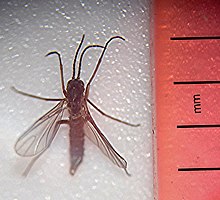眼蕈蚊總科:修订间差异
翻译外文链接 from en wiki |
(没有差异)
|
2018年9月9日 (日) 17:38的版本
| 本条目正在大幅修改,持續時間「2小時」,請勿在此期間編輯。 當重大編輯結束或暫時停止編輯時,請移除本模板。您可於編輯歷史中查看添加本模板的編者。 本模板是為了避免編輯衝突,請於本次重大編輯結束後立即移除本模板,讓其他編者能繼續編輯本条目。 致其他編者:當本条目最後編輯時間(2102日13时44分26秒前,刷新)距今超逾「2小時」,請直接移除本模板即可。 |

Fungus gnats,華南及海外華人社區俗稱蚊滋仔[1],是雙翅目多個科 (生物)的昆蟲的泛稱。 are small, dark, short-lived gnats, of the families Sciaridae, Diadocidiidae, Ditomyiidae, Keroplatidae, Bolitophilidae, and Mycetophilidae (order ); they comprise six of the seven families placed in the 科 (生物) Sciaroidea.
Description
The 幼体e of most species feed on 真菌, decaying plant material, or plant roots, helping in the 分解作用 of 有機物質. However some species are predatory, including those in the genus Arachnocampa of family Keroplatidae - the "glowworms" of New Zealand and Australia.[2]
The adults are 2—8毫米(0.079—0.315英寸) long, and are occasionally pollinators of plants and carriers of 蕈類 spores.[來源請求] They also may carry diseases such as pythium (which causes "猝倒病" to kill seedlings) on their feet.[3]
Most fungus gnats are weak fliers, and can often be seen walking rapidly over plants and soil, rather than flying. However when airborne, the gnats may be quite annoying to humans by flying into their faces, eyes, and noses, both indoors and outdoors.[4][5] These flies are sometimes confused with 蛾蚋科.[6]
Hardiness
Some fungus gnats are exceptionally hardy, being able to tolerate cold conditions through their possession of 抗凍蛋白s. Typically, overwintering organisms can either avoid freezing or tolerate freezing, but Excechia nugatoria can do both. For E. nugatoria, the production of noncolligative antifreeze proteins (NAPs) protect the head and thorax from freezing, but they do not protect the abdomen. Freezing of the head and thorax in other insects tends to have adverse effects on neural tissue, so it is not surprising that these protective mechanisms have been observed in certain species, but E. nugatoria is the only insect known to semi-freeze through the winter, which may be an evolutionary advantage. According to Sformo, by allowing the abdomen to freeze, evaporative water loss is reduced over the course of the winter.[7][8]
管治
Fungus gnats in the family Sciaridae may be pests, but are typically harmless to healthy plants - and humans - but can inflict extensive damage to seedlings; their presence can indicate more serious problems. In 觀葉植物s, the presence of sciarids may indicate overwatering; they may be feeding on roots that have been immersed in water too long and are thus rotting, or the gnats may be attracted to fungus growing in saturated topsoil. Consequently, allowing the soil to dry may reduce their numbers.[9] The pests are sometimes also managed by placing a layer of sand[10][11] or indoor mulch on top of the soil around plants; by introducing Hypoaspis miles mites or applying the biological larvicide 苏云金芽孢杆菌(Bacillus thuringiensis var. israelensis)以殺滅蚊滋的幼蟲; by drenching the soil annually in an insecticidal soap. 过氧化氢 can be mixed with water and used to kill fungus gnat larvae in infected soil with a mixture of one part 3% hydrogen peroxide mixed with four parts water, then applied to the soil.[5][6] Adults can be trapped with yellow sticky traps made of yellow card stock or heavy paper coated in an adhesive since the adults are attracted to the color yellow.[12][13]
Since the gnats are weak fliers, fan-based traps as well as other fly-killing devices may be used to help control free-flying gnats, especially indoors. There are a number of toxic and non-toxic methods of controlling sciarids and their larvae, including 线虫动物门s, 矽藻土, or powdered 桂皮.[5]
Commercial greenhouses typically employ the insect growth regulator diflubenzuron for control of fungus gnats and their larvae. It is applied to infected soil and will kill fungus gnat larvae for 30-60 days from a single application. Its mechanism of action is to interfere with 甲殼素 production and deposition and it also triggers insect larvae to molt early without a properly formed exoskeleton, resulting in the death of the larvae. Although it is targeted at fungus gnat larvae, care should be taken in applying it as it is highly toxic to aquatic invertebrates. Diflubenzuron typically has no toxic effect on adults; only the larvae are affected. [14][15]
參考文獻
- ^ 心滿意屋:蟲不喜歡孤單一個,am1430,2018-09-09 13:25 GMT-4
- ^ Morris, Lulu. HAVE YOU SEEN THE DAZZLING GLOWING WORMS OF AUSTRALIA AND NEW ZEALAND?. nationalgeographic.com.au. nationalgeographic.com.au. [31 July 2018].
- ^ Ecogrow Fungus Gnat. 17 March 2014.
- ^ Fungus Gnats (advice) 互联网档案馆的存檔,存档日期August 8, 2015,.
- ^ 5.0 5.1 5.2 Controlling Fungus Gnats and Damping Off Organically. Small Footprint Family. [2016-03-18].
- ^ 6.0 6.1 11 Sure Ways of Getting Rid of Gnats. Cover Images. February 23, 2016 [2016-03-18].
- ^ Fungus gnats survive winter half frozen.
- ^ Sformo, Todd; Kohl, F.; McIntyre, J.; Kerr, P.; Duman, J. G.; Barnes, B. M. Simultaneous freeze tolerance and avoidance in individual fungus gnats, Exechia nugatoria. Journal of Comparative Physiology B. 1 October 2009, 179 (7): 897–902. doi:10.1007/s00360-009-0369-x –通过link.springer.com.
- ^ W.S. Cransaw and R. A. Cloyd. "Fungus Gnats as Houseplant and Indoor Pests". 2009.
- ^ Jan Riggenbach."Fungus gnats and plants don’t mix".
- ^ John Brittnacher."Pests -- Fungus Gnat Larvae"
- ^ How to Get Rid of Fungus Gnats - Planet Natural.
- ^ Controlling Fungus Gnats Organically - Small Footprint Family. 8 April 2012.
- ^ ADEPT Insect Growth Regulator
- ^ Adept label

